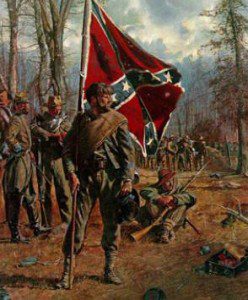
They wore uniforms highlighted in grey, and broad-brimmed army slouch hats. They carried tents, kit sacks, ammunition and Enfield rifles considered state-of-the-art during the American Civil War. They were troops of the Confederate Army of General Robert E. Lee. And last weekend they were defeated by the Federal Army of General George G. Meade in a re-enactment of the 1863 Battle of Gettysburg. To my surprise, several Canadians were among the Confederate re-enactors, including Lesley Peplinski, of Paris, Ontario.
“I am the colour sergeant for the 10th Louisiana Regiment,” she told me between re-enactment stages of the famous battle. “And it’s historically accurate.”“The disguise too?” I asked.
“There were as many as 500 women (disguised as men) serving in the Northern and Southern forces, including famous Canadian Sarah Emma Edmonds of New Brunswick.”
Last weekend, I joined tens of thousands of American tourists who converged on the sleepy town of Gettysburg, Pennsylvania, to observe the 150th anniversary of the historic three-day battle – July 1 to 3, 1863 – which Pres. Abraham Lincoln described in his later Gettysburg Address as the impetus for “a new birth of freedom.”
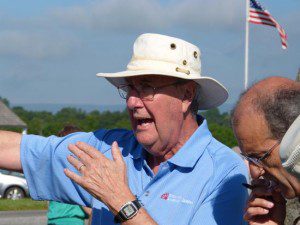
Having joined one of the battle’s foremost interpreters, Canadian Civil War guide Paul Van Nest, of Kingston, I learned about the stout defence by Buford at Seminary Ridge, the courage by example of Burgwyn at Willoughby’s Run, the near death of young Custer the cavalry officer at Hunterstown, the bayonet defence at Little Round Top, the great gamble of the Pickett-Pettigrew-Trimble charge, and about the lone Gettysburg civilian fatality in the battle, Jennie Wade.
Van Nest personalized every step of the battle with vivid detail, honest emotion and a personal sense of loss whichever side was winning or losing. He knew the story that well.
“Put me blindfolded anywhere on that 25 square miles of battlefield, and I can tell you where it is and what happened there,” said Van Nest, not bragging, but acknowledging that he’s been to Gettysburg over 180 times.
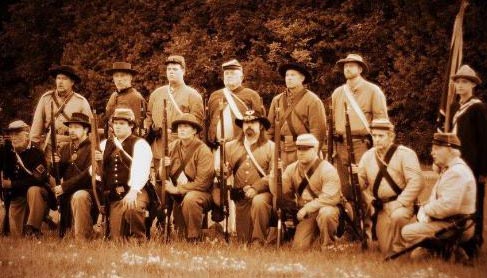
Bob Wood, another trooper (from London, Ontario) re-enacting in the 10th Louisiana Regiment at last weekend’s Gettysburg commemoration, discovered his passion for Civil War history less deliberately than guide Van Nest or female-in-disguise Peplinski. Now 63, Wood remembers being bored after retiring from Ford in 2007, when a friend invited him to a Civil War roundtable, then to a re-enactment drill and graduation. He was hooked.
Wood managed to find a complete uniform from a dealer in the States. A gunsmith in Strathroy, Ontario, sold him an original 1862 Enfield rifle. He got a tent reproduction and pair of Brogan boots from a boot-maker near Cambridge all to make him look authentic. Before long. he was attending 10 or a dozen re-enactments a year – including several at Milton and Collingwood in Canada.
“It was instant love of the hobby,” Wood said last Saturday afternoon in a stifling 100-degree-Fahrenheit heat. He and Peplinski ate lunch in their tent waiting for the conclusion of the weekend’s re-enactment. “Some of us have even been fortunate to appear in Civil War movies, such as “Gettysburg” and “Gods and Generals.”
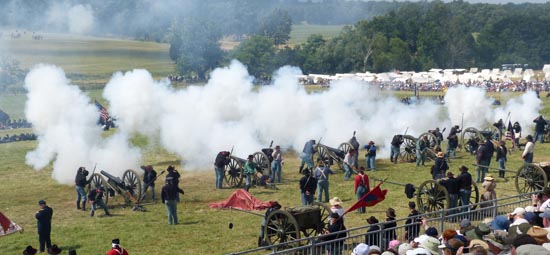
The climax for all – tour guides, tourists, history buffs, commentators, dignitaries, videographers, local citizens and re-enactors alike – occurred on Sunday afternoon. In yet another day of blistering heat (when big-top tents, parasols and water-over-the-head were the only relief), at the re-enactment park outside Gettysburg, organizers planned the grand finale of the weekend.
During an event, the programs identified as “the High Water Mark” of General Lee’s attempt to turn the Civil War in his favour, the last simulation of the day featured the infamous Pickett-Pettigrew-Trimble charge. At precisely 3:30, nearly 100 battery crews began a continuous artillery barrage. They were firing blanks, but the pounding was relentless and deafening.
“It’s the largest assembly of Civil War artillery in 148 years,” the announcer commented to the grandstands (the tens of thousands of spectators). “And preparing to re-enact Pickett’s Charge are re-enactors from all over the world.”
Men and women in Confederate and Union uniforms were there from Switzerland, Ireland, Sweden, Germany, Israel, Belgium, the U.K., Japan, Australia, Spain, Italy, Denmark, France, Bahamas, Indonesia, Scotland, South Africa, Poland, Korea, Wales and Canada. Not to mention the horses of the cavalry and the spouses and families who’d fed them, financed them and fussed over them to make them look the part.
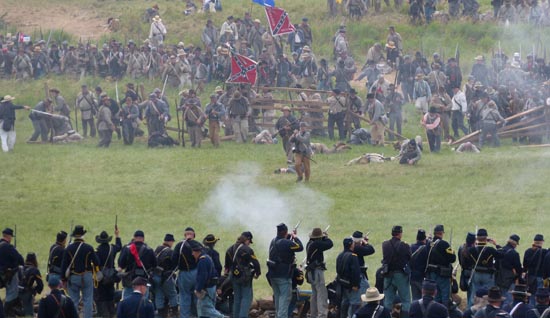
Following the hour-long artillery barrage, nearly 22,000 re-enactors engaged on the huge valley battlefield before us. We watched as the Gen. Lee employed half-century old Napoleonic tactics against rifled Union muskets and rifled Union cannons giving Federal defenders a longer range and higher accuracy advantage. But historical fact didn’t take away from the re-enactment drama.
“Imagine doing this for five solid years,” re-enactor Bob Wood remarked on his way to the showdown. “It gives you goose bumps.”
Unlike real soldiers, fortunately, re-enactors always live to fight another day.
A good column, Ted! Thank you for doing it.
The only correction I would make is the movie title: `Gods and Generals`.
Ted, wonderful photographs and excellent comments on the Gettysburg re-enactment. Your blog is the next best thing to being there and smelling the smoke of gunpowder.
Wonderful perspective! A great view of an important event through the eyes of a professional writer.
Ted, it was great to read your article. You certainly captured the event. I have not had an opportunity to review my photos but seeing yours brings back the excitement of the trip. Thank you also for the recognition you gave Paul. Travelling with him over the years has been very enriching.
Hi Ted,
Good piece on Whitney!
Not sure if you’ll remember me, but I used to be an entertainment writer/TV critic for the Calgary Herald. I one wrote a column about a terrific series you did for CBC Radio on the great songwriters. Is that series available for purchase anywhere, either through you or CBC Radio? Or is it one of those broadcasting gems that are doomed to remain in the archives because of copyright complications?
And Ted lives to write another day! Nicely done, a powerful accounting of an amazing time. Thanks for tantalizing my memory synapses by painting pictures of such a sensational occurrence that changed the tide of men. We are lucky to have you as our official chronicler of all things past and present.
Write on!